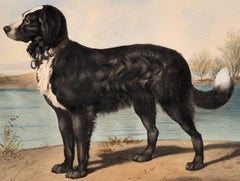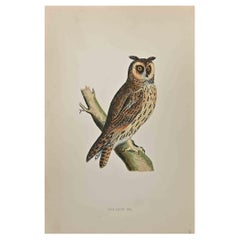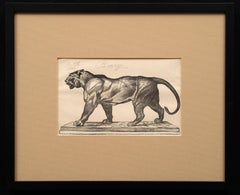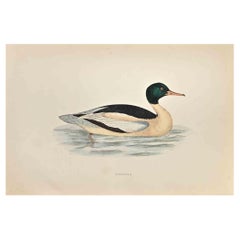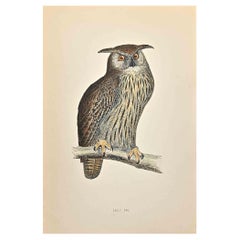1870s Animal Prints
to
59
313
12
11
1
Overall Width
to
Overall Height
to
311
3
2
2
2
2
709
1,435
2,633
1,844
31
29
67
169
102
136
246
605
363
332
678
207
130
327
317
55
17
12
10
6
6
5
5
5
4
4
4
4
4
3
3
3
3
305
20
8
5
4
12
297
91
18
Period: 1870s
Antique Dog Lithograph Taste of Alfred De Dreux, France ca. 1870 Newfoundland
By Alfred de Dreux
Located in SANTA FE, NM
Antique Dog Portrait
Lithograph in the Taste of Alfred De Dreux
Newfoundland
France, circa 1870
Lithography
25 5/8 x 19 5/8 (28 x 20 frame) inches
Six lithographs of dog portraits...
Category
Romantic 1870s Animal Prints
Materials
Lithograph
Long-Eared Owl - Woodcut Print by Alexander Francis Lydon - 1870
Located in Roma, IT
Long-Eared Owl is a modern artwork realized in 1870 by the British artist Alexander Francis Lydon (1836-1917) .
Woodcut print, hand colored, published by London, Bell & Sons, 1870....
Category
Modern 1870s Animal Prints
Materials
Woodcut
Antoine Louis-Barye "Walking Tiger" Antique Engraving by Firmin Gillot ca. 1870
Located in SANTA FE, NM
"Walking Tiger"
Antoine Louis-Barye
Antique Engraving by Firmin Gillot
Circa. 1870
11 1/3 x 7 3/4 (21 3/8 x 17 1/2 frame) inches
This is "Walking Tig...
Category
Realist 1870s Animal Prints
Materials
Black and White
Shieldrake - Woodcut Print by Alexander Francis Lydon - 1870
Located in Roma, IT
Shieldrake is a modern artwork realized in 1870 by the British artist Alexander Francis Lydon (1836-1917) .
Woodcut print, hand colored, published by London, Bell & Sons, 1870. Na...
Category
Modern 1870s Animal Prints
Materials
Woodcut
Goosander - Woodcut Print by Alexander Francis Lydon - 1870
Located in Roma, IT
Goosander is a modern artwork realized in 1870 by the British artist Alexander Francis Lydon (1836-1917) .
Woodcut print, hand colored, published by London, Bell & Sons, 1870. Nam...
Category
Modern 1870s Animal Prints
Materials
Woodcut
Eagle Owl - Woodcut Print by Alexander Francis Lydon - 1870
Located in Roma, IT
Eagle Owl is a modern artwork realized in 1870 by the British artist Alexander Francis Lydon (1836-1917) .
Woodcut print, hand colored, published by London...
Category
Modern 1870s Animal Prints
Materials
Woodcut
Scaup - Woodcut Print by Alexander Francis Lydon - 1870
Located in Roma, IT
Scaup is a modern artwork realized in 1870 by the British artist Alexander Francis Lydon (1836-1917) .
Woodcut print, hand colored, published by London, Bell & Sons, 1870. Name of...
Category
Modern 1870s Animal Prints
Materials
Woodcut
$166 Sale Price
30% Off
Gadwall - Woodcut Print by Alexander Francis Lydon - 1870
Located in Roma, IT
Gadwall is a modern artwork realized in 1870 by the British artist Alexander Francis Lydon (1836-1917) .
Woodcut print, hand colored, published by London, Bell & Sons, 1870. Name...
Category
Modern 1870s Animal Prints
Materials
Woodcut
Little Owl - Woodcut Print by Alexander Francis Lydon - 1870
Located in Roma, IT
Little Owl is a modern artwork realized in 1870 by the British artist Alexander Francis Lydon (1836-1917).
Woodcut print on ivory-colored paper.
Hand-colo...
Category
Modern 1870s Animal Prints
Materials
Woodcut
Short-Eared Owl - Woodcut Print by Alexander Francis Lydon - 1870
Located in Roma, IT
Short-Eared Owl is a modern artwork realized in 1870 by the British artist Alexander Francis Lydon (1836-1917) .
Woodcut print, hand colored, published by London, Bell & Sons, 1870...
Category
Modern 1870s Animal Prints
Materials
Woodcut
Great White Heron - Woodcut Print by Alexander Francis Lydon - 1870
Located in Roma, IT
Hawk Owl is a modern artwork realized in 1870 by the British artist Alexander Francis Lydon (1836-1917) .
Woodcut print, hand colored, published by London, Bell & Sons, 1870. Nam...
Category
Modern 1870s Animal Prints
Materials
Woodcut
Pochard - Woodcut Print by Alexander Francis Lydon - 1870
Located in Roma, IT
Pochard is a modern artwork realized in 1870 by the British artist Alexander Francis Lydon (1836-1917).
Woodcut print on ivory-colored paper.
...
Category
Modern 1870s Animal Prints
Materials
Woodcut
Great Northern Diver - Woodcut Print by Alexander Francis Lydon - 1870
Located in Roma, IT
Great Northern Diver is a modern artwork realized in 1870 by the British artist Alexander Francis Lydon (1836-1917).
Woodcut print on ivory-colored pap...
Category
Modern 1870s Animal Prints
Materials
Woodcut
White Owl - Woodcut Print by Alexander Francis Lydon - 1870
Located in Roma, IT
White Owl is a modern artwork realized in 1870 by the British artist Alexander Francis Lydon (1836-1917) .
Woodcut print, hand colored, published by Londo...
Category
Modern 1870s Animal Prints
Materials
Woodcut
Tengmalm's Owl - Woodcut Print by Alexander Francis Lydon - 1870
Located in Roma, IT
Tengmalm's Owl is a modern artwork realized in 1870 by the British artist Alexander Francis Lydon (1836-1917).
Woodcut print on ivory-colored paper.
Hand-colored, published by Lond...
Category
Modern 1870s Animal Prints
Materials
Woodcut
Snowy Owl - Woodcut Print by Alexander Francis Lydon - 1870
Located in Roma, IT
Snowy Owl a modern artwork realized in 1870 by the British artist Alexander Francis Lydon (1836-1917) .
Woodcut print, hand colored, published by London, Bell & Sons, 1870. Name ...
Category
Modern 1870s Animal Prints
Materials
Woodcut
Andalusian Quail - Woodcut Print by Alexander Francis Lydon - 1870
Located in Roma, IT
Andalusian Quail is a modern artwork realized in 1870 by the British artist Alexander Francis Lydon (1836-1917).
Woodcut print on ivory-colored paper.
Hand-colored, published by Lo...
Category
Modern 1870s Animal Prints
Materials
Woodcut
Night Heron - Woodcut Print by Alexander Francis Lydon - 1870
Located in Roma, IT
Night Heron is a modern artwork realized in 1870 by the British artist Alexander Francis Lydon (1836-1917).
Woodcut print on ivory-colored paper.
Hand-colored, published by London,...
Category
Modern 1870s Animal Prints
Materials
Woodcut
Passenger Pigeon - Woodcut Print by Alexander Francis Lydon - 1870
Located in Roma, IT
Passenger Pigeon is a modern artwork realized in 1870 by the British artist Alexander Francis Lydon (1836-1917) .
Woodcut print, hand colored, publi...
Category
Modern 1870s Animal Prints
Materials
Woodcut
The First Meeting, Jerome Park, N. Y. , H. Schile 1873 Rare Proof before letters
Located in Paonia, CO
The First Meeting, Jerome Park, N. Y. is an original proof before letters of a hand colored lithograph published in 1873 by the prolific German American artist and publisher Henry Schile...
Category
Other Art Style 1870s Animal Prints
Materials
Lithograph
Shoveler - Woodcut Print by Alexander Francis Lydon - 1870
Located in Roma, IT
Shoveler is a modern artwork realized in 1870 by the British artist Alexander Francis Lydon (1836-1917) .
Woodcut print, hand colored, published by London, Bell & Sons, 1870. Nam...
Category
Modern 1870s Animal Prints
Materials
Woodcut
American White-Winged Crossbi - Woodcut Print by Alexander Francis Lydon - 1870
Located in Roma, IT
American White-Winged Crossbill is a modern artwork realized in 1870 by the British artist Alexander Francis Lydon (1836-1917) .
Woodcut print, hand colored, published by London, B...
Category
Modern 1870s Animal Prints
Materials
Woodcut
Jay - Woodcut Print by Alexander Francis Lydon - 1870
Located in Roma, IT
Jay is a modern artwork realized in 1870 by the British artist Alexander Francis Lydon (1836-1917).
Woodcut print on ivory-colored paper.
Hand-colored, published by London, Bell & ...
Category
Modern 1870s Animal Prints
Materials
Woodcut
Little Egret - Woodcut Print by Alexander Francis Lydon - 1870
Located in Roma, IT
Little Egret is a modern artwork realized in 1870 by the British artist Alexander Francis Lydon (1836-1917).
Woodcut print on ivory-colored paper.
Hand-colored, published by London...
Category
Modern 1870s Animal Prints
Materials
Woodcut
Egyptian Vulture - Woodcut Print by Alexander Francis Lydon - 1870
Located in Roma, IT
Egyptian Vulture is a modern artwork realized in 1870 by the British artist Alexander Francis Lydon (1836-1917) .
Woodcut print, hand colored, publi...
Category
Modern 1870s Animal Prints
Materials
Woodcut
Nutcracker - Woodcut Print by Alexander Francis Lydon - 1870
Located in Roma, IT
Nutcracker is a modern artwork realized in 1870 by the British artist Alexander Francis Lydon (1836-1917).
Woodcut print on ivory-colored paper.
Hand-colored, published by London, ...
Category
Modern 1870s Animal Prints
Materials
Woodcut
La Mort du Chat Murr - Etching by Jean François Raffaëlli - 1875
Located in Roma, IT
Etching on laid paper
Inscribed in pencil: Épreuve tirée de la planche donnée personnellement par l’artiste pour la Société des Aquafortistes
Published by Cadart & Luquet, Éditeu...
Category
Modern 1870s Animal Prints
Materials
Drypoint, Etching
Lesser Black-Backed Gull - Woodcut Print by Alexander Francis Lydon - 1870
Located in Roma, IT
Lesser Black-Backed Gull is a modern artwork realized in 1870 by the British artist Alexander Francis Lydon (1836-1917) .
Woodcut print, hand colored, published by London, Bell & S...
Category
Modern 1870s Animal Prints
Materials
Woodcut
Wigeon- Woodcut Print by Alexander Francis Lydon - 1870
Located in Roma, IT
Wigeon is a modern artwork realized in 1870 by the British artist Alexander Francis Lydon (1836-1917).
Woodcut print on ivory-colored paper.
Hand-colored, published by London, Bell...
Category
Modern 1870s Animal Prints
Materials
Woodcut
Redstart - Woodcut Print by Alexander Francis Lydon - 1870
Located in Roma, IT
Redstart is a modern artwork realized in 1870 by the British artist Alexander Francis Lydon (1836-1917) .
Woodcut print, hand colored, published by London, Bell & Sons, 1870. Name...
Category
Modern 1870s Animal Prints
Materials
Woodcut
Four Pheasants
By Joseph Wolf
Located in London, GB
WOLF, Joseph (artist)
Four Pheasants
London, For the author, Red Lion Court, Fleet Street, 1871
Four original hand-coloured lithographic plates by Joseph Smit after Joseph Wo...
Category
Naturalistic 1870s Animal Prints
Materials
Watercolor, Gouache, Lithograph
La Mort du Chat Murr - Etching by Jean François Raffaëlli - 1875
Located in Roma, IT
Etching on laid paper
Signed in plate lower left: Jean François Raffaëlli.
Published by Cadart & Luquet, Éditeurs, 79 Rue Richelieu, Paris
With the blindstamp of the Société des Aqua...
Category
Modern 1870s Animal Prints
Materials
Drypoint, Etching
19th century color lithograph horses chariot figures dynamic landscape
Located in Milwaukee, WI
"Fast Trotting in the West (Milwaukee Race)" is an original hand-colored lithograph published by Currier & Ives. It depicts two horses pulling racing carts. The text below the picture reads "Fast Trotting in the West...Lucy and Goldsmith Maid...trotting their closely contested race over the cold spring course Milwaukee, Wis. Sept. 6th 1871...Where Goldsmith Maid won the 2nd heat in 2:17!! The fastest Mile heat in harness on record. Purse $4000 $2500 to 1st $1500 to 2nd horse____ 8 in. in harness. TIME 2:20 1/2 2:17 2:20"
16 3/4" x 26" image
22" x 27 3/4" paper
35 3/4" x 41 7/8" frame
Currier & Ives produced their prints in a building at 33 Spruce Street where they occupied the third, fourth and fifth floors. The third floor was devoted to the hand operated printing presses that were built by Nat's cousin, Cyrus Currier, at his shop Cyrus Currier & Sons in Newark, NJ. The fourth floor found the artists, lithographers and the stone grinders...
Category
1870s Animal Prints
Materials
Lithograph
Chromolithograph of Quail
Located in London, GB
Chromolithograph of Ducks, laid on to contemporary card (as published).
[Charles Scribner's Sons, New York, 1878].
Alexander Pope, Jr., was an American sculptor and painter. He’s kn...
Category
Naturalistic 1870s Animal Prints
Materials
Handmade Paper, Lithograph
Bulls Fighting /// Antique Victorian Animal Landscape Etching Landscape Horse
By James Ward
Located in Saint Augustine, FL
Artist: (after) James Ward (English, 1769-1859)
Title: "Bulls Fighting"
Portfolio: The Portfolio
*Signed by Wise in pencil lower right. It is also signed in the plate (printed signat...
Category
Victorian 1870s Animal Prints
Materials
Laid Paper, Etching, Intaglio
Antique Dog Lithograph, Taste of Alfred De Dreux, France circa 1870 Greyhounds D
By Alfred de Dreux
Located in SANTA FE, NM
Antique Dog Portrait
Lithograph in the Taste of Alfred De Dreux
Greyhounds D
France, circa 1870
Lithography
25 5/8 x 19 5/8 (28 x 20 frame) inc...
Category
Romantic 1870s Animal Prints
Materials
Lithograph
Antique Dog Lithograph Taste of Alfred De Dreux, France ca. 1870 Bulldog & Frog
By Alfred de Dreux
Located in SANTA FE, NM
Antique Dog Portrait
Lithograph in the Taste of Alfred De Dreux
Bulldog and Frog
France, circa 1870
Lithography
25 5/8 x 19 5/8 (28 x 20 frame) inches
Six lithographs of dog portr...
Category
Romantic 1870s Animal Prints
Materials
Lithograph
Antique Dog Lithograph Taste of Alfred De Dreux, France ca. 1870 Saint Bernard A
By Alfred de Dreux
Located in SANTA FE, NM
Antique Dog Portrait
Lithograph in the Taste of Alfred De Dreux
Saint Bernard
France, circa 1870
Lithography
25 5/8 x 19 5/8 (28 x 20 frame) inches
Six lithographs of dog portrait...
Category
Romantic 1870s Animal Prints
Materials
Lithograph
Turtle Dove - Woodcut Print by Alexander Francis Lydon - 1870
Located in Roma, IT
Turtle Dove is a modern artwork realized in 1870 by the British artist Alexander Francis Lydon (1836-1917) .
Woodcut print, hand colored, published by London, Bell & Sons, 1870. ...
Category
Modern 1870s Animal Prints
Materials
Woodcut
Hoopoe - Woodcut Print by Alexander Francis Lydon - 1870
Located in Roma, IT
Hoopoe is a modern artwork realized in 1870 by the British artist Alexander Francis Lydon (1836-1917).
Woodcut print on ivory-colored paper.
Hand-colored, published by London, Bell...
Category
Modern 1870s Animal Prints
Materials
Woodcut
Le Haut d'Un Battant de Porte - Etching by Félix Bracquemond - 1870s
Located in Roma, IT
Le Haut d'Un Battant de Porte is an artwork realized by Félix Bracquemond in the 1870s.
Etching.
image size: 28x38
Good conditions.
Realized for the "Société des Aquafortistes. ...
Category
Modern 1870s Animal Prints
Materials
Etching
Red-Breasted Merganser - Woodcut Print by Alexander Francis Lydon - 1870
Located in Roma, IT
Red-Breasted Merganser is a modern artwork realized in 1870 by the British artist Alexander Francis Lydon (1836-1917) .
Woodcut print, hand colored, published by London, Bell & Son...
Category
Modern 1870s Animal Prints
Materials
Woodcut
Two Guinea Fowl
By Joseph Wolf
Located in London, GB
WOLF, Joseph (artist).
Two Guinea Fowl
London For the author, Red Lion Court, Fleet Street 1871
Two original hand-coloured lithographic plates by Joseph Smit after Joseph Wolf. ...
Category
1870s Animal Prints
Materials
Paper, Watercolor, Gouache, Lithograph
Les Cigognes - Etching by Félix Bracquemond - 1870s
Located in Roma, IT
Les Cigognes is an artwork realized by Félix Bracquemond in the 1870s.
Etching.
Good conditions.
Realized for the "Société des Aquafortistes. Born on the initiative of the publi...
Category
Modern 1870s Animal Prints
Materials
Etching
Antoine Louis-Barye "Walking Lion" Antique Engraving by Firmin Gillot ca. 1870
Located in SANTA FE, NM
"Walking Lion"
Antoine Louis-Barye (France, 1775-1895)
Antique Engraving by Firmin Gillot
Circa. 1870
11 1/3 x 7 3/4 (21 3/8 x 17 1/2 frame) inches
This is "Walking Lion," along with "Walking Tiger...
Category
Realist 1870s Animal Prints
Materials
Black and White
Antique Dog Lithograph, Taste of Alfred De Dreux, France circa 1870 Wolfhound E
By Alfred de Dreux
Located in SANTA FE, NM
Antique Dog Portrait
Lithograph in the Taste of Alfred De Dreux
Wolfhound E
France, circa 1870
Lithography
25 5/8 x 19 5/8 (28 x 20 frame) inches
Six lithographs of dog portraits....
Category
Romantic 1870s Animal Prints
Materials
Lithograph
Scoter - Woodcut Print by Alexander Francis Lydon - 1870
Located in Roma, IT
Scoter is a modern artwork realized in 1870 by the British artist Alexander Francis Lydon (1836-1917).
Woodcut print on ivory-colored paper.
Hand-colored, published by London, Bell...
Category
Modern 1870s Animal Prints
Materials
Woodcut
Group of Six Water Fowl
Located in London, GB
POPE Jr., Alexander
Group of Six Water Fowl.
Group of Six chromolithographs of game-birds, each laid on to contemporary card (as published).
[Charles Scribner's Sons, New York, 1878].
Alexander Pope...
Category
Naturalistic 1870s Animal Prints
Materials
Lithograph
Pied Wagtail - Woodcut Print by Alexander Francis Lydon - 1870
Located in Roma, IT
Pied Wagtail is a modern artwork realized in 1870 by the British artist Alexander Francis Lydon (1836-1917).
Woodcut print on ivory-colored paper.
Hand-colored, published by London...
Category
Modern 1870s Animal Prints
Materials
Woodcut
Blackbird - Woodcut Print by Alexander Francis Lydon - 1870
Located in Roma, IT
Blackbird is a modern artwork realized in 1870 by the British artist Alexander Francis Lydon (1836-1917) .
Woodcut print, hand colored, published by London, Bell & Sons, 1870. Na...
Category
Modern 1870s Animal Prints
Materials
Woodcut
Ayant Couru à Chantilly - Etching by Jacques-Joseph Lecurieux - 1870s
Located in Roma, IT
Ayant Couru à Chantilly is an artwork realized by Jacques-Joseph Lecurieux in the 1870s.
Etching.
Good conditions.
Realized for the "Société des Aquafortistes. Born on the init...
Category
Modern 1870s Animal Prints
Materials
Etching
Sommets d'Auvergnelaure - Etching by Jules Laurens - 1870s
Located in Roma, IT
Sommets d'Auvergnelaure is a black and white etching realized by Jules Laurens (1825–1901) in 1870s.
Titled in the lower.
Image size: 23cmx30.5cm.
Very Good condition.
Signed in ...
Category
Modern 1870s Animal Prints
Materials
Etching
Crane - Woodcut Print by Alexander Francis Lydon - 1870
Located in Roma, IT
Crane is a modern artwork realized in 1870 by the British artist Alexander Francis Lydon (1836-1917).
Woodcut print on ivory-colored paper.
Hand-colored, published by London, Bell ...
Category
Modern 1870s Animal Prints
Materials
Woodcut
Raid on a Sand-Swallow Colony How Many Eggs? After Winslow Homer wood engraving
Located in Paonia, CO
Raid On A Sand-Swallow Colony " How Many Eggs?" is an original wood engraving from Harper’s Weekly June 13, 1874 in very good condition.
One of Am...
Category
1870s Animal Prints
Materials
Woodcut
Antique Dog Lithograph, Taste of Alfred De Dreux, France ca. 1870 Mastiff C
By Alfred de Dreux
Located in SANTA FE, NM
Antique Dog Portrait
Lithograph in the Taste of Alfred De Dreux
Mastiff C
France, circa 1870
Lithography
25 5/8 x 19 5/8 (28 x 20 frame) inches
Six lithographs of dog portraits.
...
Category
Romantic 1870s Animal Prints
Materials
Lithograph
A Lying Animal - Original Lithograph by F. Specht - 1880
Located in Roma, IT
A Lying Animal is a black and white print realized by Friedrich Specht in 1880.
Lithograph on dark paper. Original Title: Derendet.
Dated 1880, p.24. Signed by the artist on the r...
Category
Naturalistic 1870s Animal Prints
Materials
Lithograph
Trumpeter Swan. (Young).
Located in New York, NY
Original stone lithograph with hand-coloring from "Birds of North America." First Octavo Edition, by John James Audubon. Plate 383. Philadelphia, J.T. Bowen, ca. 1839-44.
Category
1870s Animal Prints
Materials
Paper
Griffon Vulture - Woodcut Print by Alexander Francis Lydon - 1870
Located in Roma, IT
Griffon Vulture is a modern artwork realized in 1870 by the British artist Alexander Francis Lydon (1836-1917) .
Woodcut print, hand colored, published by London, Bell & Sons, 187...
Category
Modern 1870s Animal Prints
Materials
Woodcut
Virginian Partridge - Woodcut Print by Alexander Francis Lydon - 1870
Located in Roma, IT
Virginian Partridge is a modern artwork realized in 1870 by the British artist Alexander Francis Lydon (1836-1917).
Woodcut print on ivory-colored paper.
Hand-colored, published by...
Category
Modern 1870s Animal Prints
Materials
Woodcut
Hooper - Woodcut Print by Alexander Francis Lydon - 1870
Located in Roma, IT
Hooper is a modern artwork realized in 1870 by the British artist Alexander Francis Lydon (1836-1917) .
Woodcut print, hand colored, published by London, Bell & Sons, 1870. Name o...
Category
Modern 1870s Animal Prints
Materials
Woodcut
$166 Sale Price
30% Off
Still Thinking About These?
All Recently ViewedMore Ways To Browse
Penguin Lithograph
Peter Klucik
Pheasant Engraving
Picasso Dove Of Peace
Picasso Le Taureau
Picasso Rooster
Ronald Smith
Rooster Print Picasso
Salvador Dali Argus
Salvador Dali Unicorn
Sam Savitt
Shore Bird Print
Space Elephant Dali
Szabolcs Bozo
The Toad Picasso
Vintage Forest Service Posters
Vintage Posters Coppertone
Warhol Siberian Tiger
